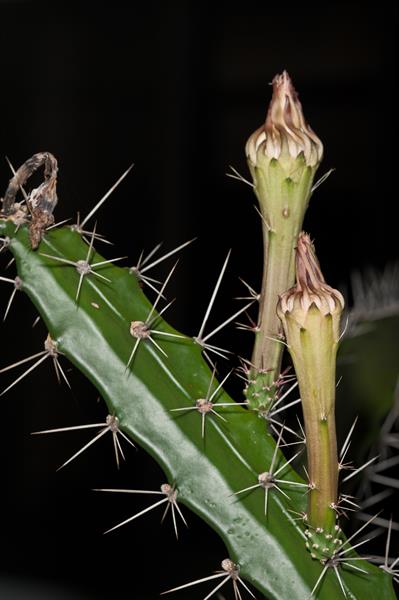
Contributed by Aidan Campos & Alan Weakley
A family of about 110-139 genera and about 1450-1800 species, perennial herbs, shrubs, vines, and trees, endemic to tropical, subtropical, and temperate America (a single species, Rhipsalis baccifera, occurring as well in Africa, Madagascar, and Sri Lanka, presumably as a result of long-distance dispersal from the Americas), with centers of diversity in sw. United States-n. Mexico, s. South America, and the West Indies. The base chromosome number for the family is n=11.
Ref: Anderson (2001); Barthlott & Hunt In Kubitzki, Rohwer, & Bittrich (1993); Benson (1982); Britton & Rose (1937); Fenstermacher (2016); Hunt et al. (2006); Nyffeler & Eggli (2010); Parfitt & Gibson (2003a) In Flora of North America Editorial Committee (2003b); Powell & Weedin (2004); Weniger (1984). Show full citations.
Hover over a shape, letter, icon, or arrow on the map for definition or see the legend. Data for arrows not developed for genera and families which may have species only occurring outside the flora area.
 © Sonnia Hill | Coryphantha sulcata | Original Image ⭷
© Sonnia Hill | Coryphantha sulcata | Original Image ⭷ © Keith Bradley | Harrisia | Original Image ⭷
© Keith Bradley | Harrisia | Original Image ⭷ © Keith Bradley | Acanthocereus | Original Image ⭷
© Keith Bradley | Acanthocereus | Original Image ⭷ © Aidan Campos | Consolea source | Original Image ⭷
© Aidan Campos | Consolea source | Original Image ⭷ © Aidan Campos | Opuntia source | Original Image ⭷
© Aidan Campos | Opuntia source | Original Image ⭷ © Erik Danielson | Opuntia source | Original Image ⭷
© Erik Danielson | Opuntia source | Original Image ⭷ © Aidan Campos | Pelecyphora source | Original Image ⭷
© Aidan Campos | Pelecyphora source | Original Image ⭷ © Alan Cressler: Cylindropuntia leptocaulis, Tucson Mountains, Tucson Mountain Park, Pima County, Arizona 2 by Alan Cressler | Cylindropuntia source | Original Image ⭷
© Alan Cressler: Cylindropuntia leptocaulis, Tucson Mountains, Tucson Mountain Park, Pima County, Arizona 2 by Alan Cressler | Cylindropuntia source | Original Image ⭷ © Keith Bradley | Opuntia | Original Image ⭷
© Keith Bradley | Opuntia | Original Image ⭷ © Alan Cressler: Harrisia fragrans, Atlantic Coastal Ridge, St. Lucie County, Florida 1 by Alan Cressler | Harrisia source | Original Image ⭷
© Alan Cressler: Harrisia fragrans, Atlantic Coastal Ridge, St. Lucie County, Florida 1 by Alan Cressler | Harrisia source | Original Image ⭷ © Alan Cressler: ariocarpus fissuratus terlingua sinkhole brewster co tx 4 by Alan Cressler source | Original Image ⭷
© Alan Cressler: ariocarpus fissuratus terlingua sinkhole brewster co tx 4 by Alan Cressler source | Original Image ⭷ © Keith Bradley | Cylindropuntia | Original Image ⭷
© Keith Bradley | Cylindropuntia | Original Image ⭷ © Richard & Teresa Ware | Opuntia CC-BY-NC, permission granted to NCBG | Original Image ⭷
© Richard & Teresa Ware | Opuntia CC-BY-NC, permission granted to NCBG | Original Image ⭷ © Alan Cressler: Echinocereus triglochidiatus, White Mule Canyon, Guadalupe Mountains, Lincoln National Forest, Eddy County, New Mexico 1 by Alan Cressler | Echinocereus source | Original Image ⭷
© Alan Cressler: Echinocereus triglochidiatus, White Mule Canyon, Guadalupe Mountains, Lincoln National Forest, Eddy County, New Mexico 1 by Alan Cressler | Echinocereus source | Original Image ⭷ © Alan Cressler: Cylindropuntia leptocaulis, Pecos River Canyon, Amistad National Recreation Area, Val Verde County, Texas 1 by Alan Cressler | Cylindropuntia source | Original Image ⭷
© Alan Cressler: Cylindropuntia leptocaulis, Pecos River Canyon, Amistad National Recreation Area, Val Verde County, Texas 1 by Alan Cressler | Cylindropuntia source | Original Image ⭷ © Keith Bradley | Acanthocereus | Original Image ⭷
© Keith Bradley | Acanthocereus | Original Image ⭷ © Scott Ward | Opuntia austrina | Original Image ⭷
© Scott Ward | Opuntia austrina | Original Image ⭷ © Aidan Campos | Cylindropuntia source | Original Image ⭷
© Aidan Campos | Cylindropuntia source | Original Image ⭷ © Alan Cressler: Mammillaria prolifera var. texana, Lost Maples State Natural Area, Bandera County, Texas 1 by Alan Cressler | Mammillaria source | Original Image ⭷
© Alan Cressler: Mammillaria prolifera var. texana, Lost Maples State Natural Area, Bandera County, Texas 1 by Alan Cressler | Mammillaria source | Original Image ⭷ © Matt Reala, some rights reserved (CC BY-NC), uploaded by Matt Reala | Lophophora williamsii source | Original Image ⭷
© Matt Reala, some rights reserved (CC BY-NC), uploaded by Matt Reala | Lophophora williamsii source | Original Image ⭷Feedback
See something wrong or missing on about Cactaceae? Let us know here: (Please include your name and email if at all complicated so we can clarify if needed.)
Cite as...